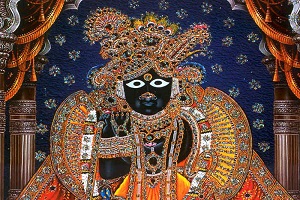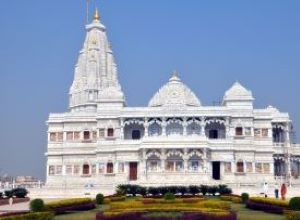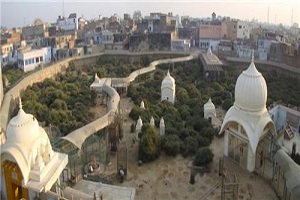Places And Temples to visit in Vrindavan

The childhood abode of Lord Krishna, is a popular pilgrimage destination located in a bend in the Yamuna River in Braj Bhoomi. Vrindavan’s name comes from vrinda (tulsi) and vana (forest), since tulsi trees once covered the area. Just seven miles north of Krishna’s birthplace, it is a two-hour drive from Delhi. Here occurred many of Krishna’s boyhood leelas or pastimes, most famously the raas leela, or dance, with Radha and the gopis. Even now their dance is believed to take place every night in Nidhivan Kunj and Seva Kunj, the two small groves of tulsi trees that remain in this now heavily developed area. Vrindavan is just a few miles away from Mathura, built on the forest where lord Krishna spent his youthful days in the company of cattle’s, maidens, and cowherds. This favorite romantic haunt of Radha Krishna - the divine couple, exudes the quietude of the countryside and sanctity of a holy place. Each meandering alley has traces of holiness and temples dedicated to Radha Krishna boasting of innumerable flashes from the historical pages. As sweet as the Peda of Mathura is to the tongue, so is the ‘Radhe Radhe’ of Vrindavan to the ears. Inarguably one of the popular pilgrimage destinations in North India, Vrindavan lets its people experience the spiritual illumination.
Take a tour to some of the famous temples in vrindavan:

Constructed in 1864, Banke Bihari is the most visited and attractive temple of Vrindavan. Banke means bent in three places and Bihari means supreme enjoyer. The main attraction here is the mesmerizing black idol believed to be a charming image left by Lord Krishna himself after appearing in person to one of his devotees Swami Haridas.

A timeless, eternal elegance beholding lustrous charm, prem mandir is an epitome of art and divine love. Rasik saint Jagadguru Shri Kripalu Ji Maharaji had presented this spectacular white pearl to the holy land of vrindavan. Prem Mandir is constructed entirely of Italian marble. With its intricate carvings, the display of refined craftsmanship and the elaborate inlay work, replete with semi-precious stones, the temple is seen as a unique divine structure within Vrindavan. A circumambulation route has been constructed on the mandir prangan, the platform of the temple, enabling visitors to appreciate the beauty of the 48 panels depicting the pastimes of Shri Radha Krishna which are carved on the outer walls of the temple. The entire temple is illuminated with constantly changing lights, as is a nearby dancing water fountain.

Nidhi means Treasure and Van means forest – Nidhi van is a mysterious treasure land of Vrindavan; from the shape and size of the trees to the sounds of Ghunghroos that makes the hearer believe the myth of Lord Krishna performing Ras leela each night.It is a place of Hindu worship. The image of Bihariji was revealed by Swami Haridas Ji.

Seva Kunj is placed in the heart of Vrindavan, Swami Hit Harivansh Ji discovered this place in 1590. According to history that Shri Radha Krishna performs Rass along with Sakhis every night. It is a delineation of peace and quietness. The walls of the kunj built marbled tiles, fixed with the verses from Radhasudhanidhi. Amidst this forest, is Seva Kunj temple, decorated with beautiful paintings depicting spiritual activities of RadhKrishna.

A Dedication to Lord Ranganatha depicted as Lord Vishnu in his sheshashayi pose, resting on the coils of the sacred Sesha Naga. The temple was built in 1851 in the Dravidian style. It has a gopuram of six storeys and a gold-plated Dhwaja stambha, 50 feet high. The 'Brahmotsdav' celebration in March–April is marked by the pulling of the Temple chariots by the devotees from the temple to the adjoining gardens.
Jiva Goswami established this temple in 1542 and it is located at Seva Kunj, Vrindavan. The main deities residing here are Radha–Damodar. There is a Govardhan-sila in this temple that was worshiped by Sanatana Goswami. Once Sanatana Goswami wished to circumambulate the whole Govardhan hill. However, due to his old age he could not find the strength to take the 21 kms round pilgrimage. While Sanatana was sitting helpless one evening, lord Krishna appeared in front of him and gifted the shila with his own footprints imprinted on it. Lord Krisna gave him this sila and told him that circumambulating this sila is as good as circumambulating the whole Govardhan Hill. Since that time the Shila has been preserved and worshipped by many locals and devotees flocking here from around the world.

Built by Visvanath Cakravarti, a vaisnava scholar and poet, the temple houses the deity of Sri Radha Vinod worshiped by Lokanath Goswami (one of the contemporaries of the Six Goswamis), a Govardhana shila gifted by Lord Chaitanya to Raghunath Dasa Gosvami, the deity of Sri Vijaya Govinda worshiped by Baladeva Vidyabhusana, and a stone with the thumbprint of Lord Chaitanya. There is the small Radha-Vinoda Deities of Lokanatha Gosvami, the larger Deities of Vijaya Govinda of Baladeva Vidyabhushan, and the Radha Gokulananda Deities of Viswanath Cakravarti. The small Deity of Krishna in front of Gokulananda and the Deity of Caitanya Mahaprabhu were worshiped by Narottama Dasa Thakur. Viswanath Cakravarti arranged to have this temple built. Formerly, all the Deities in this temple were worshiped alone, in their own temples. There is a Govardhana-shila in this temple that was given by Lord Caitanya to Raghunath Das Gosvami. This shila bears the thumbprint of Lord Caitanya. He used to chant while holding the shila, pressing it to His heart or eyes. The shila was always moist with Lord Caitanya’s tears. He would place it on His head or smell it. Lord Caitanya kept this shila for three years and then gave it to Raghunatha Das.

as old as 5000 years ago, Garud the eagle friend of lord Krishna resided at this sacred site that also loops a small water lake to its side. According to mythology, lord Krishna had bestowed Kaliya the snake a fearfree environment for the snakes from Garudas within this area. Due to this blessing the kaal sarp ritual is performed here for people near and far. A glimpse of the statue of shree lord Krishna on the back of Garuda is truly spell bounding and is considered to be auspicious as it removes the obstacles and negativities from one’s life.

This temple, dating from 1627 A.D, is thought to be one of the oldest and most popular destinations for Krishna followers. It is one of the four temples (Radharaman temple, the Govindji temple and the Gopinath temple) that was built with the permission of emperor, Akbar. This building holds great importance as it stands with its original structure while the rest three temples were damaged due to some attacks or their deities were shifted to a safe place. Historians believe, that lord Krishna killed Kesi, the demon and after wards took bath at the Kesi ghat (on which the temple is situated) that brought it the name Kesi ghata temple. A pilgrimage to this holy site brings solace to the pilgrims. Every evening, prayers are offered here to Yamuna Devi in form of devotional songs along with flowers and sweets.


Coming to Mathura Vrindvan?
Now you can book your cab online and explore land of Krishna comfortably

Don't know where to go?
Now you can hire a guide online and explore land of Krishna



